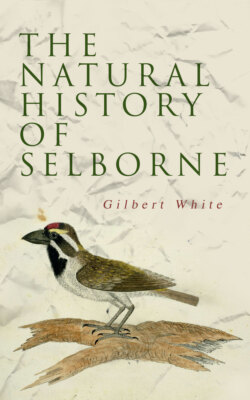Читать книгу The Natural History of Selborne - Gilbert White - Страница 8
На сайте Литреса книга снята с продажи.
LETTER III.
ОглавлениеTable of Contents
The fossil-shells of this district, and sorts of stone, such as have fallen within my observation, must not be passed over in silence. And first I must mention, as a great curiosity, a specimen that was ploughed up in the chalky fields, near the side of the Down, and given to me for the singularity of its appearance, which, to an incurious eye, seems like a petrified fish of about four inches long, the cardo passing for a head and mouth. It is in reality a bivalve of the Linnæan Genus of Mytilus, and the species of Crista Galli; called by Lister, Rastellum; by Rumphius, Ostreum plicatum minus; by D’Argenville, Auris Porci, s. Crista Galli; and by those who make collections, Cock’s Comb. Though I applied to several such in London, I never could meet with an entire specimen; nor could I ever find in books any engraving from a perfect one. In the superb museum at Leicester House, permission was given me to examine for this article; and, though I was disappointed as to the fossil, I was highly gratified with the sight of several of the shells themselves in high preservation. This bivalve is only known to inhabit the Indian Ocean, where it fixes itself to a zoophyte, known by the name Gorgonia. The curious foldings of the suture the one into the other, the alternate flutings or grooves, and the curved form of my specimen, are much easier expressed by the pencil than by words.
Cornua Ammonis are very common about this village. As we were cutting an inclining path up the Hanger, the labourers found them frequently on that steep, just under the soil, in the chalk, and of a considerable size. In the lane above Wall-head, in the way to Emshot, they abound in the bank in a darkish sort of marl, and are usually very small and soft; but in Clay’s Pond, a little farther on, at the end of the pit, where the soil is dug out for manure, I have occasionally observed them of large dimensions, perhaps fourteen or sixteen inches in diameter. But as these did not consist of firm stone, but were formed of a kind of terra lapidosa, or hardened clay, as soon as they were exposed to the rains and frost they mouldered away. These seemed as if they were a very recent production. In the chalk-pit, at the north-west end of the Hanger, large nautili are sometimes observed.
In the very thickest strata of our freestone, and at considerable depths, well-diggers often find large scallops or pectines, having both shells deeply striated, and ridged and furrowed alternately. They are highly impregnated with, if not wholly composed of, the stone of the quarry.
